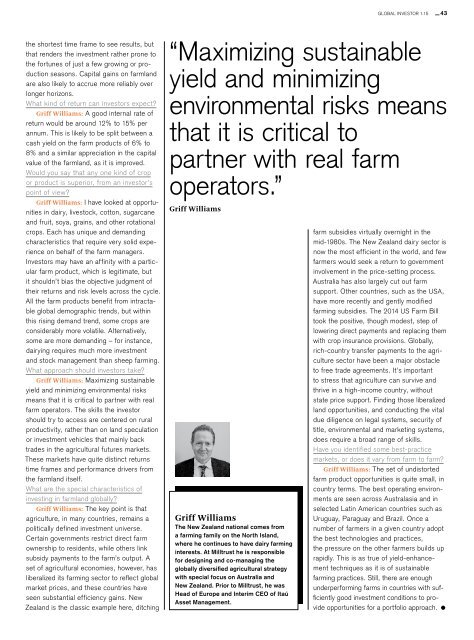Illiquid assets
Unwrapping alternative returns Global Investor, 01/2015 Credit Suisse
Unwrapping alternative returns
Global Investor, 01/2015
Credit Suisse
Create successful ePaper yourself
Turn your PDF publications into a flip-book with our unique Google optimized e-Paper software.
GLOBAL INVESTOR 1.15 — 43<br />
the shortest time frame to see results, but<br />
that renders the investment rather prone to<br />
the fortunes of just a few growing or production<br />
seasons. Capital gains on farmland<br />
are also likely to accrue more reliably over<br />
longer horizons.<br />
What kind of return can investors expect?<br />
Griff Williams: A good internal rate of<br />
return would be around 12% to 15% per<br />
annum. This is likely to be split between a<br />
cash yield on the farm products of 6% to<br />
8% and a similar appreciation in the capital<br />
value of the farmland, as it is improved.<br />
Would you say that any one kind of crop<br />
or product is superior, from an investor’s<br />
point of view?<br />
Griff Williams: I have looked at opportunities<br />
in dairy, livestock, cotton, sugarcane<br />
and fruit, soya, grains, and other rotational<br />
crops. Each has unique and demanding<br />
characteristics that require very solid experience<br />
on behalf of the farm managers.<br />
Investors may have an affinity with a particular<br />
farm product, which is legitimate, but<br />
it shouldn’t bias the objective judgment of<br />
their returns and risk levels across the cycle.<br />
All the farm products benefit from intractable<br />
global demographic trends, but within<br />
this rising demand trend, some crops are<br />
considerably more volatile. Alternatively,<br />
some are more demanding – for instance,<br />
dairying requires much more investment<br />
and stock management than sheep farming.<br />
What approach should investors take?<br />
Griff Williams: Maximizing sustainable<br />
yield and minimizing environmental risks<br />
means that it is critical to partner with real<br />
farm operators. The skills the investor<br />
should try to access are centered on rural<br />
productivity, rather than on land speculation<br />
or investment vehicles that mainly back<br />
trades in the agricultural futures markets.<br />
These markets have quite distinct returns<br />
time frames and performance drivers from<br />
the farmland itself.<br />
What are the special characteristics of<br />
investing in farmland globally?<br />
Griff Williams: The key point is that<br />
agriculture, in many countries, remains a<br />
politically defined investment universe.<br />
Certain governments restrict direct farm<br />
ownership to residents, while others link<br />
subsidy payments to the farm’s output. A<br />
set of agricultural economies, however, has<br />
liberalized its farming sector to reflect global<br />
market prices, and these countries have<br />
seen substantial efficiency gains. New<br />
Zealand is the classic example here, ditching<br />
“Maximizing sustainable<br />
yield and minimizing<br />
environmental risks means<br />
that it is critical to<br />
partner with real farm<br />
operators.”<br />
Griff Williams<br />
Griff Williams<br />
The New Zealand national comes from<br />
a farming family on the North Island,<br />
where he continues to have dairy farming<br />
interests. At Milltrust he is responsible<br />
for designing and co-managing the<br />
globally diversified agricultural strategy<br />
with special focus on Australia and<br />
New Zealand. Prior to Milltrust, he was<br />
Head of Europe and Interim CEO of Itaú<br />
Asset Management.<br />
farm subsidies virtually overnight in the<br />
mid-1980s. The New Zealand dairy sector is<br />
now the most efficient in the world, and few<br />
farmers would seek a return to government<br />
involvement in the price-setting process.<br />
Australia has also largely cut out farm<br />
support. Other countries, such as the USA,<br />
have more recently and gently modified<br />
farming subsidies. The 2014 US Farm Bill<br />
took the positive, though modest, step of<br />
lowering direct payments and replacing them<br />
with crop insurance provisions. Globally,<br />
rich-country transfer payments to the agriculture<br />
sector have been a major obstacle<br />
to free trade agreements. It’s important<br />
to stress that agriculture can survive and<br />
thrive in a high-income country, without<br />
state price support. Finding those liberalized<br />
land opportunities, and conducting the vital<br />
due diligence on legal systems, security of<br />
title, environmental and marketing systems,<br />
does require a broad range of skills.<br />
Have you identified some best-practice<br />
markets, or does it vary from farm to farm?<br />
Griff Williams: The set of undistorted<br />
farm product opportunities is quite small, in<br />
country terms. The best operating environments<br />
are seen across Australasia and in<br />
selected Latin American countries such as<br />
Uruguay, Paraguay and Brazil. Once a<br />
number of farmers in a given country adopt<br />
the best technologies and practices,<br />
the pressure on the other farmers builds up<br />
rapidly. This is as true of yield-enhancement<br />
techniques as it is of sustainable<br />
farming practices. Still, there are enough<br />
underper forming farms in countries with sufficiently<br />
good investment conditions to provide<br />
opportunities for a portfolio approach.

















